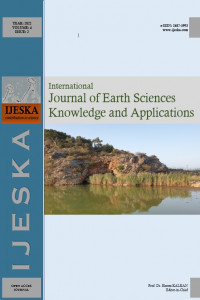Cracking and Causes of Ground Displacement in Rawat Rawalpindi Pakistan (Causes and Effect Report)
Cracking and Causes of Ground Displacement in Rawat Rawalpindi Pakistan (Causes and Effect Report)
___
- Farid, A., Khalid, P., Ali, M.Y., Iqbal, M.A., Jadoon, K.Z., 2018. Seismic Stratigraphy of the Mainwali and Bannu Depressions, North-western Indus Foreland Basin. International Journal of Earth Sciences 107 (5), 1557-1578.
- Hassan, M.A., 1972. Soil survey report in Punjab for agriculture and non-agricultural development in Pakistan. Soil Survey Development Punjab, Pakistan.
- Kazmi, A.H., Jan, M.Q., 1997. Geology and tectonics of Pakistan. Graphics Publishers, Karachi.
- Khalid, P., Khurram, S., Raza, Z., 2020. Hypocenter relocation and velocity model for major earthquakes in Northwest Himalaya. Arabian Journal of Science and Engineering 13, 1240
- Khalid, P., Bajwa, A.A., Naeem, M., Din, Z.U., 2016. Seismicity distribution and focal mechanism solution of major earthquakes of Northern Pakistan. Acta Geodaetica et Geophysica 51 347-357.
- Khurram, S., Khalid, P., Din, Z.U., Atif, A.S., Bahija, A., 2020. Integrated Study of geotechnical and geophysical methods for assessing the soil corrosion potential for construction site. International Journal of Economic and Environmental Geology 11 (3), 79-85.
- Lisa, M., Khawaja, A.A., Ghazi, G.R., Jadoon, I.A., Hashmi, S., 1997. Nature of faults and focal mechanism solutions of a part of northern Pakistan. Geology Bulletin University of Peshawar 30, 143-151.
- Rafi, Z., Hyder, A., 2012. Seismic hazard analysis and zonation for the northern areas of Pakistan and Kashmir. Report by Pakistan Meteorological Department, pp 1-62.
- Salena, I.Y., 2016. A case study of foundation failure in the exiting residential building. Jurnal Teknik Sipil Fakultas Teknik Universitas Teuku Umar 2 (1), 91-103.
- Seeber, L., Armbruster, J., 1979. Seismicity of the Hazara Arc in northern Pakistan: décollement versus basement faulting, in Geodynamics of Pakistan, A. Farah and K. A. DeJong, Eds., Geological Survey of Pakistan, Quetta, 131-142.
- Seeber, L.J., Armbruster, J.G., Quittmeyer, R., 1981. Seismicity and continental collision in the Himalayan Arc, in Zagros, Hindu-Kush, Himalaya, Geodynamic Evolution, Geodynamical Series, Vol 3, 215-242, AGU, Washington, D.C.
- Verma, R.K., 1991. Seismicity of the Himalaya and the northeast India, and nature of continent-continent collision. Physics and Chemistry of the Earth 18, 345-370.
- Başlangıç: 2019
- Yayıncı: Ekrem KALKAN
Mohammadreza ELMİ, Abdulmannan ROUHANİ, Ehsan KESHAVARZ
Sumaira Asif KHAN, Adnan KHAN, Muhammad YOUNUS, Salman ARİF
Collins O. EİGBİKE, Isaac O. IMASUEN, Festus OBOMESE, Daniel Imariabe OMORUYİ
An Experimental Study of the Effect of CO2 Water-Mancos Shale Interactions on Permeability
James SHENG, Jiahui ZHAO, Ping YUE
Adebo BABATUNDE, Ilugbo Stephen OLUBUSOLA, Jemiriwon Emmanuel TOPE, Ali Adnan KARRAM, Akinwumi Ayomide KOLAWOLE, Adeniken Nathaniel TAİWO
Urban Heat Island Effect: A Case Study of Jaipur, India
Anindita BHATTACHARJEE, Sheetal KAMBLE, Neel KAMAL, Prachi GOLHAR, Vishakha KUMARİ, Akshey BHARGAVA
Geophysical Probing in Geotechnical Investigation for Shear Wave Velocity Assessment
Shahzada KHURRAM, Perveiz KHALİD, Zia UD DİN
Osakpolor Marvellous OMOROGİEVA, Isaac OKİTİ
